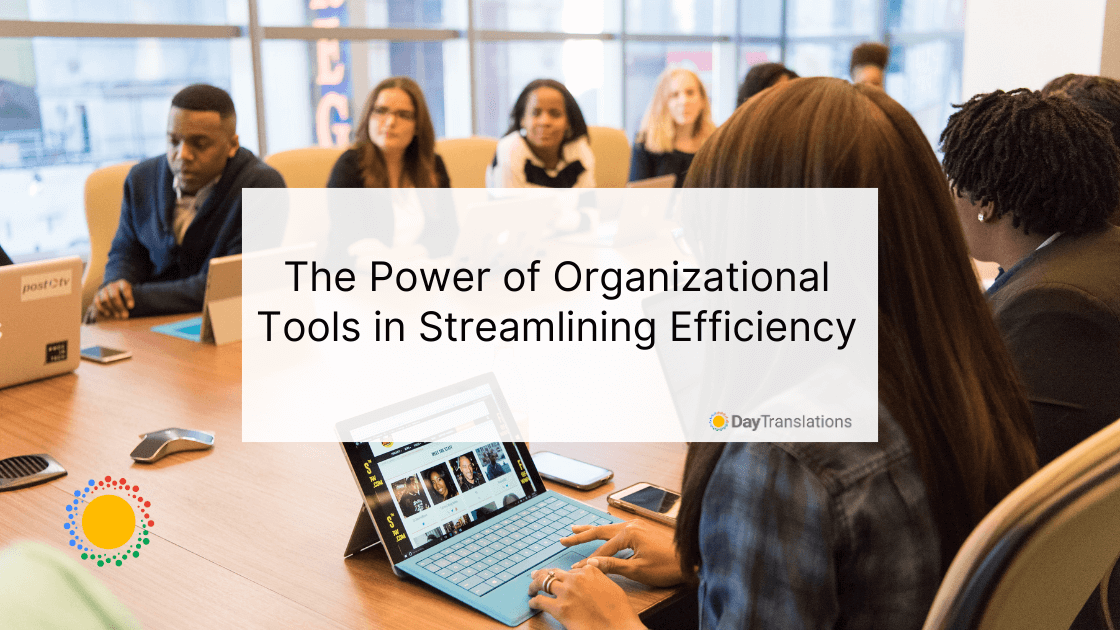In today’s fast-paced business environment, effective communication and collaboration are the cornerstones of success for any organization. However, the plethora of apps and tools available for teams can often lead to confusion, inefficiency, and increased costs. This article will explore the benefits of reducing the number of apps used within teams and highlight the advantages of multifunctional organizational tools. We’ll also delve into the Day Interpreting App and the Free Translation Tool from Day Translations, as well as draw insights from a recent Harvard Business Review article on the challenges posed by collaboration tools.
The Pitfalls of App Overload
As organizations strive to improve their productivity and collaboration, they often turn to various specialized apps and software solutions. While these tools may serve a specific purpose, they can create a fragmented digital workspace that hinders productivity. The Harvard Business Review article “Are Collaboration Tools Overwhelming Your Team?” emphasizes the downsides of this approach, citing the risks of information silos, user fatigue, and reduced engagement.
The Benefits of Simplification
Reducing the number of apps within a team’s toolkit can lead to several key advantages. First and foremost, it streamlines communication and collaboration, making it easier for team members to find and share information. This simplification also reduces new employees’ learning curve and minimizes the data duplication or loss risk. Additionally, it can positively impact the organization’s bottom line by cutting down on software licensing and subscription costs.
Multifunctional Tools for Multilingual Communication
The Day Interpreting App is one innovative solution to streamline team communication while reducing app overload. This multifunctional tool bridges language barriers and facilitates seamless multilingual communication within teams. With real-time interpretation capabilities, teams can connect with colleagues, clients, and partners worldwide without needing external interpreters or language-specific apps.
Key features of the Day Interpreting App:
- Real-time translation and interpretation.
- Support for multiple languages.
- Integration with popular team communication platforms.
Free Translation Tool from Day Translations
In addition to the Day Interpreting App, Day Translations offers a Free Translation Tool that can further enhance team efficiency. This tool provides automated translation services, allowing team members to quickly translate documents, emails, or messages into different languages. It’s a valuable asset for organizations operating in global markets or working with international teams.
Key features of the Free Translation Tool:
- User-friendly interface.
- Support for a wide range of languages.
- Quick and accurate translations.
Implementing Multifunctional Organizational Tools in Your Company
While the use of multifunctional tools can greatly benefit companies in monetary aspects and improve the baseline productivity of their teams, there are a few things to keep in mind for rolling out tools and apps designed to multitask. As such, staying ahead of the technology curve is essential for survival. The latest innovations in apparel inventory management software, for instance, offer unprecedented opportunities for efficiency, sustainability, and customer engagement. However, embracing these changes requires more than just a willingness to adapt; it demands a comprehensive strategy for navigating the technological shift.
Here’s what you need to know:
Integration and Compatibility
In the realm of organizational tools for teams, one of the paramount considerations is the seamless integration and compatibility of these tools with an organization’s existing software ecosystem. This aspect cannot be overstated, as it directly impacts the effectiveness and efficiency of collaborative efforts.
When tools can harmoniously integrate with established platforms such as agency project management systems, communication tools, and document repositories, it reduces the friction in the workflow. Team members can easily access and share information without constant app-switching, resulting in a more streamlined and productive work environment. Moreover, integration minimizes data duplication, ensuring that information is consistent and up-to-date across all platforms.
By incorporating solutions like IT asset management software, such as Freshworks, organizations can further enhance integration capabilities while maintaining optimal control over their technological resources. Digital asset management system insights enable teams to optimize collaborative processes and maximize the benefits of their tools.
User Training and Onboarding
Comprehensive user training and onboarding process are critical to successfully adopting organizational tools within teams. These processes are pivotal in ensuring that team members embrace the new tools and use them effectively. Even the most powerful tools can become underutilized without adequate training, leading to user frustration and hampering productivity.
On the other hand, effective onboarding can ease the transition by familiarizing team members with the tools’ functionalities, best practices, and shortcuts. This introduction is particularly vital when introducing tools with unique features or interfaces. Moreover, providing ongoing support and resources for users as they navigate these tools can help them become proficient more quickly, reducing resistance to change and enhancing the organization’s ability to leverage these tools to their fullest potential. User training and onboarding, therefore, should be regarded as investments in successfully integrating new tools into a team’s workflow.
Customization and Scalability
Customization and scalability are pivotal factors when considering organizational tools for teams. These features empower organizations to tailor the tools to align precisely with their unique workflows and evolving needs. Customization allows teams to adapt the tools to their specific processes, ensuring a seamless fit and enhancing user adoption. For instance, a CRM tool that can be customized to match the intricate details of a company’s sales processes can significantly boost efficiency.
Scalability is also crucial, particularly for growing organizations. Tools that can expand effortlessly to accommodate an increasing number of users, projects, or data volumes ensure that the investment in these tools remains sustainable over time. The ability to adjust and grow with the organization promotes long-term cost savings and guarantees that the tools remain valuable assets as the team and its demands expand. Customization and scalability together enable organizations to mold their tools to their unique requirements while providing the flexibility needed to thrive in an ever-changing business landscape.
Emerging Trends
The landscape of organizational tools for teams is continuously evolving, with several exciting trends shaping how teams collaborate and work together. Integrating artificial intelligence (AI) and automation into these tools is a prominent trend. AI-powered virtual assistants are revolutionizing the workplace by automating routine tasks, providing data insights, and enhancing decision-making processes.
Additionally, augmented reality (AR) is emerging as a game-changer for remote collaboration and training. Industries such as manufacturing and healthcare leverage AR to facilitate real-time guidance and troubleshooting, even across great distances.
These trends collectively demonstrate the evolving landscape of organizational tools, where technology continues to drive innovation, efficiency, and new possibilities for teams and organizations alike. As these trends mature, they are likely to reshape the way teams collaborate and interact, offering exciting opportunities for enhanced productivity and effectiveness.
Challenges and Pitfalls
While adopting organizational tools can bring numerous benefits, it’s crucial to acknowledge and address the challenges and potential pitfalls that organizations may encounter during the implementation process. Resistance to change is a common challenge, as team members may be accustomed to their existing workflows and may resist adopting new tools.
Technical issues, such as compatibility problems or software glitches, can also disrupt the implementation process. Furthermore, there is the risk of investing in tools that do not align with the organization’s unique needs, leading to inefficiencies or underutilization.
To mitigate these challenges, organizations should prioritize thorough user training and communication, ensuring that team members understand the benefits of the new tools. Additionally, a phased implementation approach can help teams gradually adapt to the changes, reducing resistance.
Regular feedback and assessment can identify and address any technical issues promptly. A realistic perspective that acknowledges these challenges and plans to overcome them is essential for successfully transitioning to new organizational tools.
Wrapping Up
In conclusion, while the abundance of collaboration tools may seem like a boon for teams, it can often lead to confusion and inefficiency. Streamlining the number of apps used within a team can have profound benefits, both professionally and monetarily. The Day Interpreting App and Free Translation Tool from Day Translations offer innovative solutions to simplify communication and bridge language gaps. By embracing multifunctional tools, organizations can foster a more productive and cost-effective work environment, ultimately driving success in today’s competitive business landscape.












Sorry, the comment form is closed at this time.